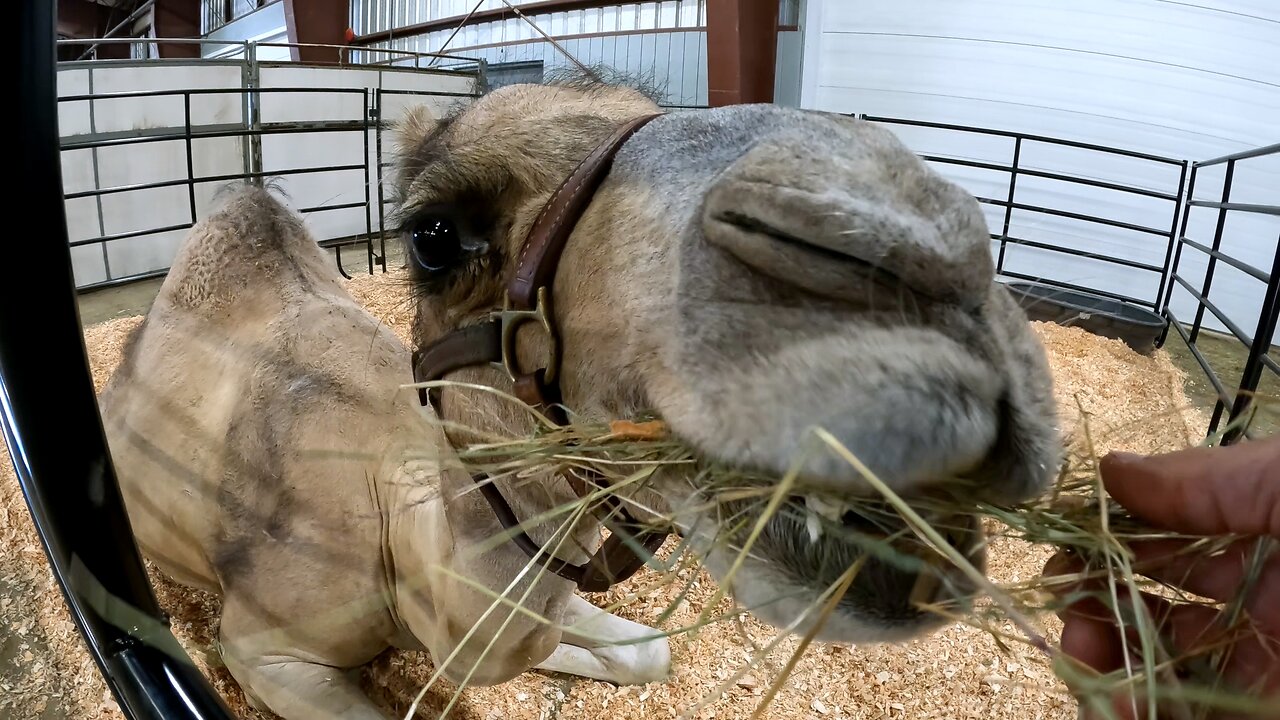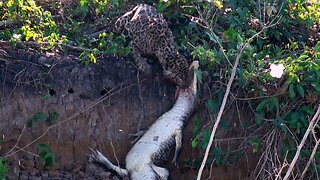Premium Only Content

Very chill camel enjoys a tasty snack
This camel is completely relaxed as he spends the day at a fair in Chilliwack, British Columbia. He's very comfortable with people and he happily allows anyone to pet him and scratch his ears. He'll also happily take a handful of fresh, green hay. He munches contentedly as the people passing by stop to get a close look.
Camels are sturdy mammals known for their distinctive physical characteristics, which enable them to thrive in harsh desert environments.
Camels are large, with adult camels standing about 6 to 7 feet (1.8 to 2.1 meters) tall at the shoulder. They can weigh between 880 to 1,320 pounds (400 to 600 kg).
One of the most distinguishing features is the hump on their back. There are two main species of camels. A dromedary (Arabian) Camel has one hump. A Bactrian camel has two humps. A camel's humps store fat, which can be converted into energy and water when food is scarce.
Camels have large, tough mouths that are well-suited for eating thorny desert vegetation. They have slit-like nostrils that can close to protect against sand and dust. Their eyes are large, with long eyelashes that help keep sand out, and a third eyelid (nictitating membrane) that provides additional protection. Camels have long, powerful legs, which help them walk long distances and carry heavy loads. Their broad, flat feet are specially adapted for walking on sand, with tough, leathery pads that prevent sinking. Camels have thick fur that helps insulate them from both the heat and cold. In the summer, they shed much of this fur to keep cool.
Their coat color ranges from light brown to beige, providing natural camouflage in desert environments. Camels are highly adapted to conserve water. They can drink large amounts of water quickly (up to 40 gallons in one go) and can survive for long periods without drinking.
Camels can tolerate body temperature fluctuations that would be fatal to most other animals, which helps them avoid sweating and thus conserve water.
These characteristics make camels well-suited to life in arid and semi-arid regions, where they have been used by humans for transportation, food, and other resources for thousands of years.
-
 2:12
2:12
WildCreatures
2 months ago $3.29 earnedThe beauty and mystery of the Pantanal, Brazil's best secret
24.5K5 -
 LIVE
LIVE
Steven Crowder
2 hours agoMamdani's Anti-White Victory Must Be America's Wake Up Call
24,267 watching -
 LIVE
LIVE
Dr Disrespect
1 hour ago🔴LIVE - DR DISRESPECT - ARC RAIDERS - AGAINST ALL DANGER
930 watching -
 DVR
DVR
Simply Bitcoin
3 hours agoThe Bitcoin Crucible w/ Alex Stanczyk ft Tomer Strolight - Episode 7
85 -
 17:33
17:33
a12cat34dog
3 hours agoRUMBLE TAKEOVER @ DREAMHACK | VLOG | {HALLOWEEN 2025}
667 -
 1:02:11
1:02:11
VINCE
2 hours agoPelosi Is Passing The Torch - Who's Next? | Episode 164 - 11/07/25 VINCE
120K69 -
 LIVE
LIVE
GloryJean
1 hour agoWINNING All Day Long Baby 😎
37 watching -
 LIVE
LIVE
SOLTEKGG
1 hour agoGOING FOR THE WIN WORLD RECORD - BF6 Giveaway
89 watching -
 1:06:37
1:06:37
Chad Prather
14 hours agoApplying The POWER Of Christ To Your Life!
58.8K25 -
 LIVE
LIVE
LFA TV
14 hours agoLIVE & BREAKING NEWS! | FRIDAY 11/7/25
4,004 watching